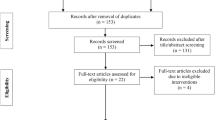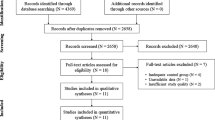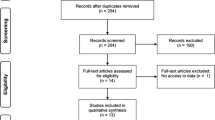Abstract
Background and purpose
Numerous research studies have shown the effects of Blood Flow Restriction (BFR) training on muscle strength and hypertrophy, but there is still no comprehensive analysis of the effects on aerobic capacity. The purpose of this study was to conduct a systematic review with meta-analysis to evaluate the qualitative and quantitative results of BFR training on aerobic capacity.
Methods
PRISMA guidelines were used to carry out the systematic review and meta-analysis. Five electronic databases were searched up to October 2020: PubMed, Web of Science, EBSCO, Scopus and Cochrane/Embase. Data selected for primary analysis consisted of post-intervention changes in VO2 values (VO2max, VO2peak). Case reports, acute studies and review studies were excluded. The protocol was registered on PROSPERO (CRD42020214919).
Results
After the elimination of duplicates, 62 records were screened. Among these, 17 studies were included in the systematic review. Twelve of these were involved in the meta-analysis.
Discussion
BFR training compared with exercise under normal blood flow conditions could positively influences both aerobic capacity and athletic performance. Differences in young and older subjects were discussed. BFR showed to be a promising and beneficial training to elicit improvements in aerobic capacity (measured in VO2) and performances.
Level of evidence
1a.




Similar content being viewed by others
References
Garber CE, Blissmer B, Deschenes MR, Franklin BA, Lamonte MJ, Lee IM, Nieman DC, Swain DP, American College of Sports Medicine (2011) American College of Sports Medicine position stand Quantity and quality of exercise for developing and maintaining cardiorespiratory, musculoskeletal, and neuromotor fitness in apparently healthy adults: guidance for prescribing exercise. Med Sci Sports Exerc 43(7):1334–1359. https://doi.org/10.1249/MSS.0b013e318213fefb
Billat VL, Demarle A, Slawinski J, Paiva M, Koralsztein JP (2001) Physical and training characteristics of top-class marathon runners. Med Sci Sports Exerc 33(12):2089–2097. https://doi.org/10.1097/00005768-200112000-00018
Gabbett TJ, Jenkins DG, Abernethy B (2011) Relationships between physiological, anthropometric, and skill qualities and playing performance in professional rugby league players. J Sports Sci 29(15):1655–1664. https://doi.org/10.1080/02640414.2011.610346
Manari D, Manara M, Zurini A, Tortorella G, Vaccarezza M, Prandelli N et al (2016) VO2Max and VO2AT: Athletic performance and field role of elite soccer players. Sport Sci Health 12:221–226
Tomlin DL, Wenger HA (2001) The relationship between aerobic fitness and recovery from high intensity intermittent exercise. Sports Med (Auckland, NZ) 31(1):1–11. https://doi.org/10.2165/00007256-200131010-00001
Kodama S, Saito K, Tanaka S, Maki M, Yachi Y, Asumi M, Sugawara A, Totsuka K, Shimano H, Ohashi Y, Yamada N, Sone H (2009) Cardiorespiratory fitness as a quantitative predictor of all-cause mortality and cardiovascular events in healthy men and women: a meta-analysis. JAMA 301(19):2024–2035. https://doi.org/10.1001/jama.2009.681
Blair SN, Kohl HW, Paffenbarger RS Jr, Clark DG, Cooper KH, Gibbons LW (1989) Physical fitness and all-cause mortality. A prospective study of healthy men and women. JAMA 262(17):2395–2401. https://doi.org/10.1001/jama.262.17.2395
Hill AV, Lupton H (1923) Muscular exercise, lactic acid, and the supply and utilization of oxygen. Q J Med 16:135–171. https://doi.org/10.1093/qjmed/os-16.62.135
Hill AV, Long CNH, Lupton H (1924) Muscular exercise, lactic acid and the supply and utilisation of oxygen. Proc R Soc Lond Ser B 97(682), 155–176. http://www.jstor.org/stable/81141
Bassett DR Jr, Howley ET (2000) Limiting factors for maximum oxygen uptake and determinants of endurance performance. Med Sci Sports Exerc 32(1):70–84. https://doi.org/10.1097/00005768-200001000-00012
Whipp BJ, Ward SA (1990) Physiological determinants of pulmonary gas exchange kinetics during exercise. Med Sci Sports Exerc 22(1):62–71
Clemente Suárez VJ, González-Ravé JM (2014) Four weeks of training with different aerobic workload distributions—effect on aerobic performance. Eur J Sport Sci 14(Suppl 1):S1–S7. https://doi.org/10.1080/17461391.2011.635708
Kelley GA, Kelley KS (2008) Efficacy of aerobic exercise on coronary heart disease risk factors. Prev Cardiol 11(2):71–75. https://doi.org/10.1111/j.1751-7141.2008.08037.x
Grey TM, Spencer MD, Belfry GR, Kowalchuk JM, Paterson DH, Murias JM (2015) Effects of age and long-term endurance training on VO2 kinetics. Med Sci Sports Exerc 47(2):289–298. https://doi.org/10.1249/MSS.0000000000000398
Burgomaster KA, Moore DR, Schofield LM, Phillips SM, Sale DG, Gibala MJ (2003) Resistance training with vascular occlusion: metabolic adaptations in human muscle. Med Sci Sports Exerc 35(7):1203–1208. https://doi.org/10.1249/01.MSS.0000074458.71025.71
Takarada Y, Tsuruta T, Ishii N (2004) Cooperative effects of exercise and occlusive stimuli on muscular function in low-intensity resistance exercise with moderate vascular occlusion. Jpn J Physiol 54(6):585–592. https://doi.org/10.2170/jjphysiol.54.585
Abe T, Kawamoto K, Yasuda T, Kearns CF, Midorikawa T, Sato Y (2005) Eight days KAATSU-resistance training improved sprint but not jump performance in collegiate male track and field athletes. Int J Kaatsu Train Res 1:19–23
Loenneke JP, Kim D, Fahs CA, Thiebaud RS, Abe T, Larson RD, Bemben DA, Bemben MG (2015) Effects of exercise with and without different degrees of blood flow restriction on torque and muscle activation. Muscle Nerve 51(5):713–721. https://doi.org/10.1002/mus.24448
Takarada Y, Takazawa H, Sato Y, Takebayashi S, Tanaka Y, Ishii N (2000) Effects of resistance exercise combined with moderate vascular occlusion on muscular function in humans. J Appl Physiol (Bethesda, Md, 1985) 88(6):2097–2106. https://doi.org/10.1152/jappl.2000.88.6.2097
Loenneke JP, Wilson JM, Marín PJ, Zourdos MC, Bemben MG (2012) Low intensity blood flow restriction training: a meta-analysis. Eur J Appl Physiol 112(5):1849–1859. https://doi.org/10.1007/s00421-011-2167-x
Loenneke JP, Fahs CA, Rossow LM, Abe T, Bemben MG (2012) The anabolic benefits of venous blood flow restriction training may be induced by muscle cell swelling. Med Hypotheses 78(1):151–154. https://doi.org/10.1016/j.mehy.2011.10.014
Formiga MF, Fay R, Hutchinson S, Locandro N, Ceballos A, Lesh A, Buscheck J, Meanor J, Owens JG, Cahalin LP (2020) Effect of aerobic exercise training with and without blood flow restriction on aerobic capacity in healthy young adults: a systematic review with meta-analysis [published correction appears in Int J Sports Phys Ther. 2020 May;15(3):486]. Int J Sports Phys Ther 15(2):175–187
Bennett H, Slattery F (2019) Effects of blood flow restriction training on aerobic capacity and performance: a systematic review. J Strength Cond Res 33(2):572–583. https://doi.org/10.1519/JSC.0000000000002963
Patterson SD, Hughes L, Warmington S, Burr J, Scott BR, Owens J, Abe T, Nielsen JL, Libardi CA, Laurentino G, Neto GR, Brandner C, Martin-Hernandez J, Loenneke J (2019) Blood flow restriction exercise: considerations of methodology, application, and safety. Front Physiol 10:533. https://doi.org/10.3389/fphys.2019.00533
Vieira PJ, Chiappa GR, Umpierre D, Stein R, Ribeiro JP (2013) Hemodynamic responses to resistance exercise with restricted blood flow in young and older men. J Strength Cond Res 27(8):2288–2294. https://doi.org/10.1519/JSC.0b013e318278f21f
Sugawara J, Tomoto T, Tanaka H (2015) Impact of leg blood flow restriction during walking on central arterial hemodynamics. Am J Physiol Regul Integr Comp Physiol 309(7):R732–R739. https://doi.org/10.1152/ajpregu.00095.2015
May AK, Brandner CR, Warmington SA (2017) Hemodynamic responses are reduced with aerobic compared with resistance blood flow restriction exercise. Physiol Rep 5(3):e13142. https://doi.org/10.14814/phy2.13142
Christiansen D, Murphy RM, Bangsbo J, Stathis CG, Bishop DJ (2018) Increased FXYD1 and PGC-1α mRNA after blood flow-restricted running is related to fibre type-specific AMPK signalling and oxidative stress in human muscle. Acta Physiol (Oxf) 223(2):e13045. https://doi.org/10.1111/apha.13045
Flocco P, Galeoto G (2021) Effect of blood flow restriction training on physiological outcomes in healthy athletes: a systematic review and meta-analysis. Muscles Ligaments Tendons J (MLTJ) 11(1):101–117. https://doi.org/10.32098/mltj.01.2021.12
Moher D, Shamseer L, Clarke M, Ghersi D, Liberati A, Petticrew M, Shekelle P, Stewart LA, PRISMA-P Group (2015) Preferred reporting items for systematic review and meta-analysis protocols (PRISMA-P) 2015 statement. Syst Rev 4(1):1. https://doi.org/10.1186/2046-4053-4-1
Ouzzani M, Hammady H, Fedorowicz Z, Elmagarmid A (2016) Rayyan-a web and mobile app for systematic reviews. Syst Rev 5(1):210. https://doi.org/10.1186/s13643-016-0384-4
Higgins JP, Thomas J, Chandler J, Cumpston M, Li T, Page MJ, Welch VA (eds) (2019) Cochrane handbook for systematic reviews of interventions. Wiley
Park S, Kim JK, Choi HM, Kim HG, Beekley MD, Nho H (2010) Increase in maximal oxygen uptake following 2-week walk training with blood flow occlusion in athletes. Eur J Appl Physiol 109(4):591–600. https://doi.org/10.1007/s00421-010-1377-y
Paton CD, Addis SM, Taylor LA (2017) The effects of muscle blood flow restriction during running training on measures of aerobic capacity and run time to exhaustion. Eur J Appl Physiol 117(12):2579–2585. https://doi.org/10.1007/s00421-017-3745-3
Abe T, Fujita S, Nakajima T, Sakamaki M, Ozaki H, Ogasawara R, Sugaya M, Kudo M, Kurano M, Yasuda T, Sato Y, Ohshima H, Mukai C, Ishii N (2010) Effects of low-intensity cycle training with restricted leg blood flow on thigh muscle volume and VO2max in young men. J Sports Sci Med 9(3):452–458
Keramidas ME, Kounalakis SN, Geladas ND (2012) The effect of interval training combined with thigh cuffs pressure on maximal and submaximal exercise performance. Clin Physiol Funct Imaging 32:205–213. https://doi.org/10.1111/j.1475-097X.2011.01078.x
Kim D, Singh H, Loenneke JP, Thiebaud RS, Fahs CA, Rossow LM, Young K, Seo DI, Bemben DA, Bemben MG (2016) Comparative effects of vigorous-intensity and low-intensity blood flow restricted cycle training and detraining on muscle mass, strength, and aerobic capacity. J Strength Cond Res 30(5):1453–1461. https://doi.org/10.1519/JSC.0000000000001218
Abe T, Sakamaki M, Fujita S, Ozaki H, Sugaya M, Sato Y, Nakajima T (2010) Effects of low-intensity walk training with restricted leg blood flow on muscle strength and aerobic capacity in older adults. J Geriatr Phys Ther 33(1):34–40
Amani AR, Sadeghi H, Afsharnezhad T (2018) Interval training with blood flow restriction on aerobic performance among young soccer players at transition phase. Montenegrin J Sports Sci Med 7(2):5–10. https://doi.org/10.26773/mjssm.180901
Conceição MS, Junior E, Telles GD, Libardi CA, Castro A, Andrade A, Brum PC, Urias Ú, Kurauti MA, Júnior J, Boschero AC, Cavaglieri CR, Camera DM, Chacon-Mikahil M (2019) Augmented anabolic responses after 8-wk cycling with blood flow restriction. Med Sci Sports Exerc 51(1):84–93. https://doi.org/10.1249/MSS.0000000000001755
de Oliveira MF, Caputo F, Corvino RB, Denadai BS (2016) Short-term low-intensity blood flow restricted interval training improves both aerobic fitness and muscle strength. Scand J Med Sci Sports 26(9):1017–1025. https://doi.org/10.1111/sms.12540
Ferreira-Junior A, de Araújo AC, Chimin P et al (2019) Efect of walk training with blood fow restriction on oxygen uptake kinetics, maximum oxygen uptake and muscle strength in middle-aged adults. Med Sport 72:616–627. https://doi.org/10.23736/S0025-7826.19.03402-1
Held S, Behringer M, Donath L (2020) Low intensity rowing with blood flow restriction over 5 weeks increases V̇O2max in elite rowers: a randomized controlled trial. J Sci Med Sport 23(3):304–308. https://doi.org/10.1016/j.jsams.2019.10.002
Ozaki H, Sakamaki M, Yasuda T, Fujita S, Ogasawara R, Sugaya M, Nakajima T, Abe T (2011) Increases in thigh muscle volume and strength by walk training with leg blood flow reduction in older participants. J Gerontol Ser A Biol Sci Med Sci 66(3):257–263. https://doi.org/10.1093/gerona/glq182
Corvino RB, Oliveira M, Denadai BS, Rossiter HB, Caputo F (2019) Speeding of oxygen uptake kinetics is not different following low-intensity blood-flow-restricted and high-intensity interval training. Exp Physiol 104(12):1858–1867. https://doi.org/10.1113/EP087727
Christiansen D, Eibye K, Hostrup M, Bangsbo J (2020) Training with blood flow restriction increases femoral artery diameter and thigh oxygen delivery during knee-extensor exercise in recreationally trained men. J Physiol 598(12):2337–2353. https://doi.org/10.1113/JP279554
Libardi CA, Chacon-Mikahil MP, Cavaglieri CR, Tricoli V, Roschel H, Vechin FC, Conceição MS, Ugrinowitsch C (2015) Effect of concurrent training with blood flow restriction in the elderly. Int J Sports Med 36(5):395–399. https://doi.org/10.1055/s-0034-1390496
Manimmanakorn A, Hamlin MJ, Ross JJ, Taylor R, Manimmanakorn N (2013) Effects of low-load resistance training combined with blood flow restriction or hypoxia on muscle function and performance in netball athletes. J Sci Med Sport 16(4):337–342. https://doi.org/10.1016/j.jsams.2012.08.009
Tanaka Y, Takarada Y (2018) The impact of aerobic exercise training with vascular occlusion in patients with chronic heart failure. ESC Heart Fail 5(4):586–591. https://doi.org/10.1002/ehf2.12285
Silva J, Pereira Neto EA, Pfeiffer P, Neto GR, Rodrigues AS, Bemben MG, Patterson SD, Batista GR, Cirilo-Sousa MS (2019) Acute and chronic responses of aerobic exercise with blood flow restriction: a systematic review. Front Physiol 10:1239. https://doi.org/10.3389/fphys.2019.01239
Hays RD, Woolley JM (2000) The concept of clinically meaningful difference in health-related quality-of-life research. How meaningful is it? Pharmacoeconomics 18(5):419–423. https://doi.org/10.2165/00019053-200018050-00001
Clark NA, Edwards AM, Morton RH, Butterly RJ (2008) Season-to-season variations of physiological fitness within a squad of professional male soccer players. J Sports Sci Med 7(1):157–165
Iida H, Kurano M, Takano H, Kubota N, Morita T, Meguro K, Sato Y, Abe T, Yamazaki Y, Uno K, Takenaka K, Hirose K, Nakajima T (2007) Hemodynamic and neurohumoral responses to the restriction of femoral blood flow by KAATSU in healthy subjects. Eur J Appl Physiol 100(3):275–285. https://doi.org/10.1007/s00421-007-0430-y
Fragala MS, Kenny AM, Kuchel GA (2015) Muscle quality in aging: a multi-dimensional approach to muscle functioning with applications for treatment. Sports Med (Auckland, NZ) 45(5):641–658. https://doi.org/10.1007/s40279-015-0305-z
Acknowledgements
The authors thank Dr. Alessandro Daino for his precious assistance during the study selection phase.
Funding
No sources of funding were used to assist in the preparation of this article.
Author information
Authors and Affiliations
Corresponding author
Ethics declarations
Conflict of interest
The authors declare that they have no competing interests.
Additional information
Publisher's Note
Springer Nature remains neutral with regard to jurisdictional claims in published maps and institutional affiliations.
Rights and permissions
About this article
Cite this article
Flocco, P., Bernabei, L. Effects of blood flow restriction training on aerobic capacity: a systematic review and meta-analysis. Sport Sci Health 19, 389–403 (2023). https://doi.org/10.1007/s11332-022-00944-x
Received:
Accepted:
Published:
Issue Date:
DOI: https://doi.org/10.1007/s11332-022-00944-x




